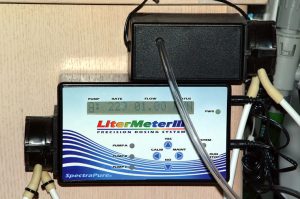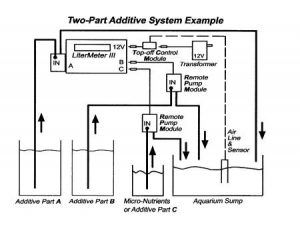I’ve always had success in keeping fish in my 500 gallon reef aquarium, even delicate fish. I couldn’t make the same statement about my two 40 gallon reef aquariums. I got to thinking about the differences between the aquariums. All have high-intensity lighting, quality skimmers, temperature controllers, vigorous water movement, live rock, live sand, etc. The one big difference was how I maintained calcium and alkalinity in the smaller aquariums. In the larger reef, I have a calcium reactor and kalkwasser dosing pump running continuously and controlled by pH controllers. In the smaller reefs, I measured pH, alkalinity and salinity on a weekly basis and adjusted accordingly.
I’ve been using B-Ionic (from ESV) on one of the smaller reef aquariums to maintain calcium and alkalinity levels. B-Ionic is the original two-part supplement designed to support calcium and alkalinity levels in reef aquariums without impacting the ionic balance of major elements. It works very well and many find it easier and safer to use than other methodologies, such as kalkwasser and calcium reactors. It’s also an economical alternative in smaller reef aquariums.
The key to using any of the two-part supplements effectively is to dose regularly and in equal amounts. I was lazy about this chore and only added B-Ionic weekly or when the alkalinity measured 2.5 meq/liter or less. I also adjusted for evaporated water on the same haphazard schedule. Although this tank did okay, the fish never displayed the same vigor, health and longevity as those in my larger reef aquarium. Corals generally did well, but never prospered at the same level as in the large reef aquarium. What I really desired was a way to automate the daily dosing of each component of B-Ionic and replace evaporated water on a continual basis. I may have been able to accomplish this dosing regimen with a series of peristaltic pumps, but that would be prohibitively expensive and difficult to synchronize. When I learned of the new LiterMeter III from Spectrapure it appeared to address all of my needs.
The LiterMeter III is a small peristaltic pump with integrated electronic timers and controls. Peristaltic pumps work by squeezing rubber tubing between rollers to lift and push a fluid through the tube. The big advantage of these pumps is that the pump mechanism never comes into contact with the fluid being transported. This is especially important when dealing with caustic chemicals, such as calcium hydroxide (kalkwasser), or chemicals that contain a precipitate that may clog pumping mechanisms. I’ve used the original LiterMeter for years and it’s proven to be a quality product. It was originally designed to dose kalkwasser and automate the replacement of evaporated water. The new LiterMeter III adds a number of features that make it the perfect solution for automating the addition of multi-part supplements. It accepts up to three independent pump heads that can be independently calibrated and controlled. This enables the aquarist to dose up to three liquids simultaneously and independent of each other.
The standard LiterMeter III comes with a single pump head. I added the optional second pump head and air-pressure switch. I’m a great believer in redundancy and insurance when it comes to everything related to my reef aquariums. The air switch attaches by suction cup to the wall of my sump. If the water level rises past a pre-determined point, the change in air pressure signals the pumps to discontinue operation. The second pump head plugs into the main controller and can be located at a considerable distance from the controller. In my situation this wasn’t necessary and I simply placed it on top of the main controller. I attached the whole unit to the side of my aquarium stand with double-sided tape. It’s resistant to minor splashes because the control panel is located behind a plastic shield.
Calibration of the pump is critical when dosing things such as two-part supplements, trace element solutions, iodide, strontium, etc. The LiterMeter III has a fool-proof calibration routine programmed into the unit. Simply press the calibration button to start the pump. Press it again after it’s pumped 500 ml of liquid. That’s it! Once each pump is calibrated, you set the total daily amount in liters to be dispensed by each pump. The LiterMeter III doses this amount over a 24 hour period in 150 increments. Each pump can be set to dose as little as 1.7 ounces to as much as 26 gallons in a 24 hour period. The pumps use just 6 watts of electricity when operating and are capable of lifting liquids 10 feet and pumping it to a height of 16 feet.
As I explained earlier, I intended to use the LiterMeter III to dose a two- part supplement, as well as replace evaporated water, on my 40 gallon reef aquarium. The total water volume in this system, including a 15 gallon sump, is approximately 50 gallons. This system loses 4 gallons of water each week to evaporation and requires 30 ml of each component of B-Ionic on a daily basis to maintain adequate levels of calcium and alkalinity. To accomplish my goal, I added a week’s worth of each component of B-Ionic to separate two- gallon vessels and filled the remainder with deionized water. This also dilutes the supplements and lessens the chance of precipitation or spikes in pH. I set the daily total for each pump to “one liter.” I only have to refill the reservoirs once each week and the system can’t overdose because of the float switch. If I find that I need to tweak the dosing, it’s a simple matter of adjusting the daily total amount, which is adjustable down to centiliters!
The LiterMeter III requires very little maintenance. There’s a service meter that issues a warning when a pump reaches 500 service hours. At this point the rollers and tubing should be inspected and cleaned. The tubing only needs to be replaced when cracked or worn through. I don’t know the service life of the tubing, but I can say that I’m still using the original tubing on my LiterMeter I and it’s been in operation for four years dosing kalkwasser!
Some of the other features of interest on the LiterMeter II include:
- It’s self-priming. It can be and should be located above the reservoir.
- It can run dry without fear of damaging the pump mechanism.
- It’s quiet enough to use in a living room without being noticed.
- It doesn’t lose its settings in the event of a power outage.
Some of the other potential uses for the LiterMeter III system include:
- It’s accurate enough to do automatic water changes. One pump can be used to remove water from the sump into a drain; the other can add new saltwater from a reservoir.
- It can be used to dose rotifers for feeding larval fish, which mean you can sleep all night, be away all day, and still raise marine fish!
- It can be used to supplement a reef aquarium with live phytoplankton.
The LiterMeter III sells for approximately $300 and comes with a one year warranty. Additional pumps are $120.
You can find more info and see a complete owner’s manual at www.spectrapure.com.
In case you’re unfamiliar with the company, Spectrapure has been selling water purification equipment and dosing pumps to the aquarium trade for many years. Their customer service, product knowledge and support have proven to be outstanding. With so many companies hawking dubious products to aquarium hobbyists, it’s important that we support and recognize those companies that have operated with integrity and for the betterment of the hobby.







0 Comments